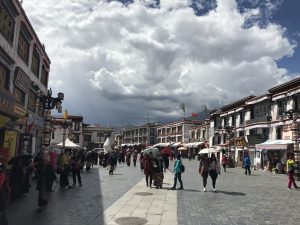 Barkhor Street is the ancient street centered on the Jokhang Temple. The Tibetan people are here to worship Buddha. Most of the streets retain the style of the ancient streets. If you want to know about the traditional Tibetan style, just go to the Barkhor Street. Leaving the main road, all the lanes of Barkhor Street can give you different surprises. You can walk into an old street, and you will find they are all Tibetans chanting. There is no tourist. It is forbidden to take pictures there. It is like the epitome of Lhasa in the past. The only difference is that there are no three lords, no serfs and nobles.
Barkhor Street is the ancient street centered on the Jokhang Temple. The Tibetan people are here to worship Buddha. Most of the streets retain the style of the ancient streets. If you want to know about the traditional Tibetan style, just go to the Barkhor Street. Leaving the main road, all the lanes of Barkhor Street can give you different surprises. You can walk into an old street, and you will find they are all Tibetans chanting. There is no tourist. It is forbidden to take pictures there. It is like the epitome of Lhasa in the past. The only difference is that there are no three lords, no serfs and nobles.
Barkhor Street is famous for two aspects. First of all, it is a famous small commodity city. There are many kinds of goods. It is the combination of Chinese and Western, and the price is very cheap, it is a good place to buy Tibetan tourist souvenirs. Secondly, you can see the Jokhang Temple and the Potala Palace worshippers. It is recommended that everyone experience it if time is available. If you don’t have time, don’t be reluctant. After all, there are too many beautiful sceneries in Tibet.
For Lhasa Barkhor Street, what the most worth seeing here is the famous Yellow House and Makye Ame, which is the meaning of “unmarried mother” in Tibetan. Behind this name it is a beautiful love story, and the love poems from the Sixth Dalai Lama, Tsangyang Gyatso, have been passed down till today.
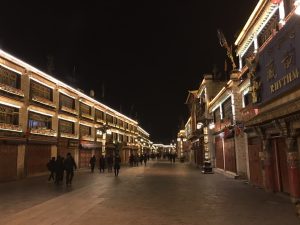 Barkhor Street is located in the old city of Lhasa. It is the famous circumanbulation and commercial center of Lhasa, which preserves the traditional appearance and living style of the ancient city. The original street of Barkhor Street is just a single circumanbulation around the Jokhang Temple. The Tibetans call it the “Holy Road”. If you are to visit Lhasa, you can take your trip to the Barkhor Street.
Barkhor Street is located in the old city of Lhasa. It is the famous circumanbulation and commercial center of Lhasa, which preserves the traditional appearance and living style of the ancient city. The original street of Barkhor Street is just a single circumanbulation around the Jokhang Temple. The Tibetans call it the “Holy Road”. If you are to visit Lhasa, you can take your trip to the Barkhor Street.
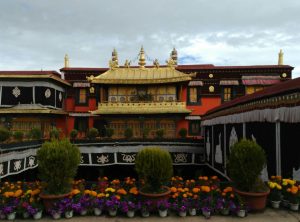 Jokhang Temple is the landmark building in the center of Lhasa, you can see the Jokhang Temple Square from the Golden Summit of the Jokhang Temple. On the far right, it is the Potala Palace. The nearby willow tree is the “Princess Willow”. It is said that it was planted by Princess Wencheng. The layout of the Jokhang Temple is different from that of the Buddhist temples of Han Dynasty. The main hall is located on the east side and faces the west side. The main hall is four stories high and has a matching hall on both sides. The layout structure reproduces the ideal mode of the universe in the Mandala city in Buddhism. The halls in the temple mainly include the Sakyamuni Hall, the Tsongkhapa Masters Hall, the Songtsan Gampu Temple, the Bandan Ram Temple (the Dharmapala of Gelugpai God), and the Tibetan King Hall etc. Due to the tourist season, many halls are not open to the public. It is only open to general tourists at 14:00 o’clock in the afternoon. Tickets for Jokhang Temple are 85 yuan. It is recommended to check the introduction of each hall in the Jokhang Temple in advance so that you can gain more.
Jokhang Temple is the landmark building in the center of Lhasa, you can see the Jokhang Temple Square from the Golden Summit of the Jokhang Temple. On the far right, it is the Potala Palace. The nearby willow tree is the “Princess Willow”. It is said that it was planted by Princess Wencheng. The layout of the Jokhang Temple is different from that of the Buddhist temples of Han Dynasty. The main hall is located on the east side and faces the west side. The main hall is four stories high and has a matching hall on both sides. The layout structure reproduces the ideal mode of the universe in the Mandala city in Buddhism. The halls in the temple mainly include the Sakyamuni Hall, the Tsongkhapa Masters Hall, the Songtsan Gampu Temple, the Bandan Ram Temple (the Dharmapala of Gelugpai God), and the Tibetan King Hall etc. Due to the tourist season, many halls are not open to the public. It is only open to general tourists at 14:00 o’clock in the afternoon. Tickets for Jokhang Temple are 85 yuan. It is recommended to check the introduction of each hall in the Jokhang Temple in advance so that you can gain more.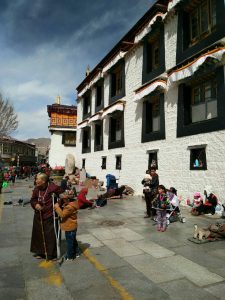
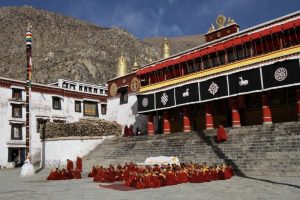 Located in the foothills of the western suburbs of Lhasa, Drepung Monastery is the largest temple in Tibetan Buddhism. The temple’s architectural complex is large in scale, with white houses and red palaces lined up on the mountainside. From afar, it looks like a huge pile of rice. The photos of Drepung Monastery taken on the mountainside are very spectacular. It is the highest-ranking temple in the Gelug Sect of Tibetan Buddhism. The interior architecture is atmospheric and magnificent, which is full of many beautiful treasures, and the Monk’s debate ceremony can be watched there.
Located in the foothills of the western suburbs of Lhasa, Drepung Monastery is the largest temple in Tibetan Buddhism. The temple’s architectural complex is large in scale, with white houses and red palaces lined up on the mountainside. From afar, it looks like a huge pile of rice. The photos of Drepung Monastery taken on the mountainside are very spectacular. It is the highest-ranking temple in the Gelug Sect of Tibetan Buddhism. The interior architecture is atmospheric and magnificent, which is full of many beautiful treasures, and the Monk’s debate ceremony can be watched there.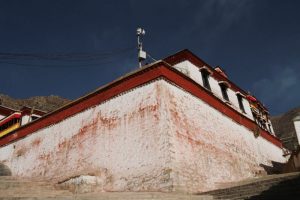
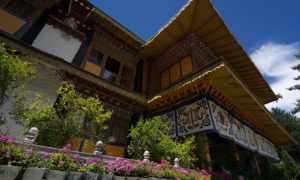 Norbulingka means “baby garden” in Tibetan language. It is the summer palace of the Dalai and Lama (the Potala Palace is the Winter Palace). Some people also call it “the Summer Palace of Lhasa.” The garden is very distinctive, and it has the shadow of Tibetan culture and also absorbs the traditional methods of gardening in the interior. There is a new palace inside, and its architecture, murals and decorations are the integration of the essence of Tibet’s major temples, palaces and buildings. It can be said that visiting the new palace is like browsing the entire Tibetan building. There are hundreds of plants in the Norbulingka, including many famous flowers such as Tibetan hydrangea, so it is also known as the Plateau Botanical Garden. During the festival, special activities such as Tibetan opera performances can be seen. Tibetans will sit in Norbulingka with tents and food, and chat with friends and family.
Norbulingka means “baby garden” in Tibetan language. It is the summer palace of the Dalai and Lama (the Potala Palace is the Winter Palace). Some people also call it “the Summer Palace of Lhasa.” The garden is very distinctive, and it has the shadow of Tibetan culture and also absorbs the traditional methods of gardening in the interior. There is a new palace inside, and its architecture, murals and decorations are the integration of the essence of Tibet’s major temples, palaces and buildings. It can be said that visiting the new palace is like browsing the entire Tibetan building. There are hundreds of plants in the Norbulingka, including many famous flowers such as Tibetan hydrangea, so it is also known as the Plateau Botanical Garden. During the festival, special activities such as Tibetan opera performances can be seen. Tibetans will sit in Norbulingka with tents and food, and chat with friends and family.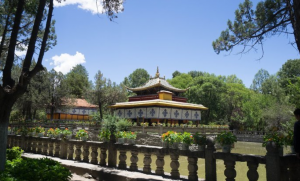
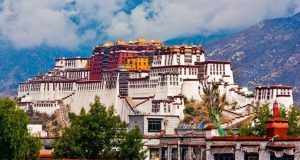 The Potala Palace is a palace, not a temple. It is politically similar to the Forbidden City and is the political center of the Tibetan region in history, not a Buddhist center. The building is divided into three parts: Snow City, White Palace and Red Palace. At this stage, there are only the East Side White Palace and some of the main halls on the east side of the Red Palace open for visiting. The west side has never been open to visitors. The tour route of The Potala Palace is very fixed. There is no turning way back. After the tour, you will leave from the mountain in the back. Here are a few things to keep in mind:
The Potala Palace is a palace, not a temple. It is politically similar to the Forbidden City and is the political center of the Tibetan region in history, not a Buddhist center. The building is divided into three parts: Snow City, White Palace and Red Palace. At this stage, there are only the East Side White Palace and some of the main halls on the east side of the Red Palace open for visiting. The west side has never been open to visitors. The tour route of The Potala Palace is very fixed. There is no turning way back. After the tour, you will leave from the mountain in the back. Here are a few things to keep in mind: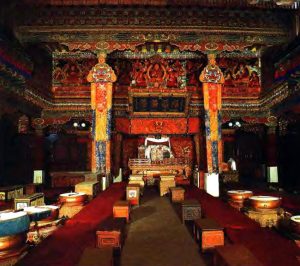
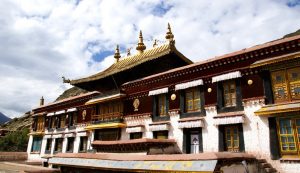 Sera Monastery, Drepung Monastery and Ganden Monastery are the three major temples in Lhasa. It was the last of the three temples to be built. There is the most famous debate ceremony in Tibetan areas. The debate was held in the northernmost debate hall in the temple. There are so many people watching the debate, and they can take a good position when coming there early.
Sera Monastery, Drepung Monastery and Ganden Monastery are the three major temples in Lhasa. It was the last of the three temples to be built. There is the most famous debate ceremony in Tibetan areas. The debate was held in the northernmost debate hall in the temple. There are so many people watching the debate, and they can take a good position when coming there early.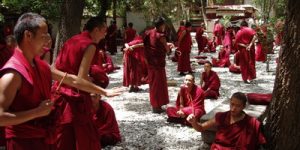 Dozens of lamas standing there, are divided into one-to-one, one-to-many, or many-to-one combinations, questioning, rebutting, refuting and then answering, using a variety of gestures, physical movements, or hands waving rosary beads, one-legged independence, even glaring at each other, vigorously claping to make a strong voice. The debate, for the monks is a practice, for tourists is like watching a lively performance.
Dozens of lamas standing there, are divided into one-to-one, one-to-many, or many-to-one combinations, questioning, rebutting, refuting and then answering, using a variety of gestures, physical movements, or hands waving rosary beads, one-legged independence, even glaring at each other, vigorously claping to make a strong voice. The debate, for the monks is a practice, for tourists is like watching a lively performance.